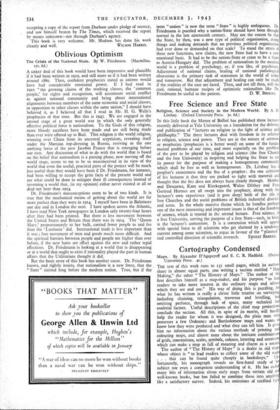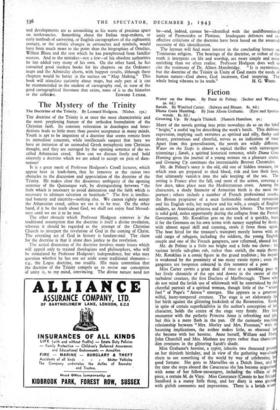Cartography Condensed
THE text of this work runs to 131 small pages, which its author share in almost equal parts, one writing a section entitled " Map Making," the other " The History of Maps." The author of th first describes himself as a map-maker, and his purpose " to lea readers to take more interest in the ordinary maps and atlase which they see and use." His way of doing this is puzzling, .fo what he has written is really a clever little treatise on surveyin including chaining, triangulation, traverses and levelling, ha omitting perforce, through lack of space, many technical .bu essential factors. Useful descriptions of the chief map projecuo conclude the section. All this, in spite of its merits, will hard! help the reader for whom it was designed, the plain man wh possesses a few Ordnanca and Bartholomew maps and wants t know how they were produced and what they can tell him. It giv him no information about the various methods of printing an colouring maps, and almost none about the intricate combination of grids, conventions, scales, symbols, colours, lettering and ornamen which can make a map as full of meaning and charm as a sonata The author of " The History of Maps " is a dealer in old ma whose object is " to lead readers to collect some of the old map . . . that can be found quite cheaply in bookshops." Un fortunately, his monograph reveals no first-hand study of hi subject, nor even a competent understanding of it. He has cull many bits of information about early maps from certain old an well-known books, but has failed to combine these into anythla like a satisfactory survey. Indeed, his omissions of cardinal fa
and developments are as astonishing as his waste of precious space on irrelevancies. Something about the Italian map-makers, or early methods of surveying, or English cartographers of the eighteenth century, or the artistic changes in cartouches and symbols, would have been much more to the point than the biographies of Ortelius, Willem Blaeu and the rest which he has paraphrased from familiar sources. And to the mistakes—not a few—of his obsolete authorities he has added very many of his own. On the other hand, he has consulted good modern books foi his chapters on the Ordnance maps and the Admiralty charts, with happier results, although these chapters would be better ;n the section on " Map Making." This book will stimulate curiosity about maps, but only part of it can be recommended to the student of cartography and, in view of the good cartographical literature that exists, none of it to the historian



























 Previous page
Previous page